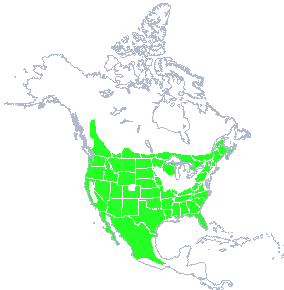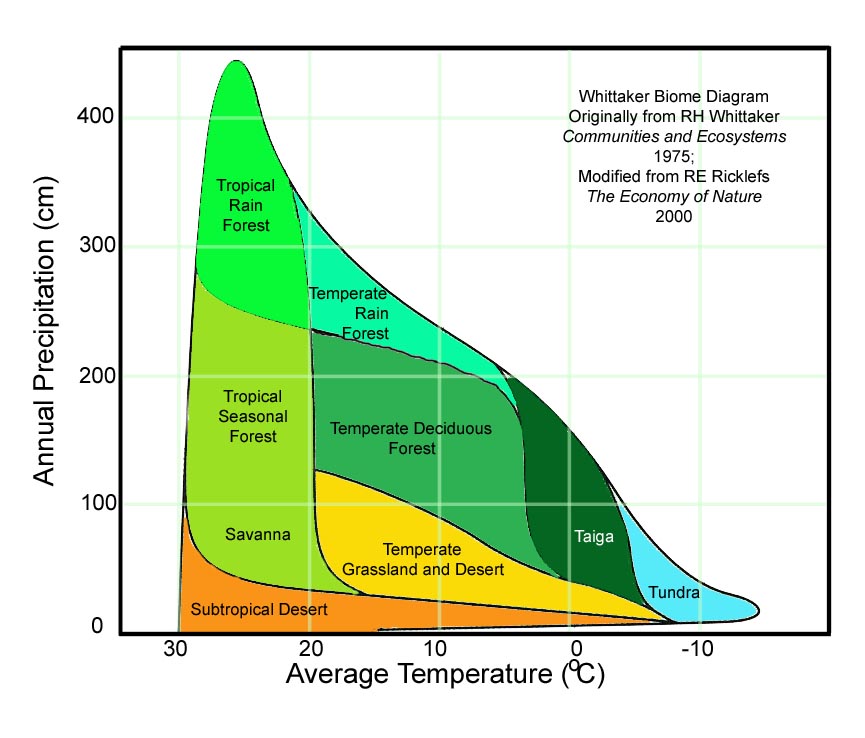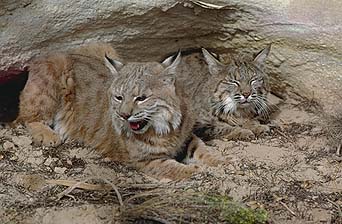
Habitat

The Lynx rufus has to capacity to thrive in a wide
variety of areas. The bobcat’s habitat spans through North America
covering east to west and from southern Mexico to Canada (Hygnstrom
2008). Rocky regions interspersed with crops are preferred by the
bobcat, but they also dwell in forests, suburban areas, swamps, and
desserts (Baugh 2011).
The reigns that the Lynx rufus inhabits are very
diverse. The terrestrial biomes where they can be found are the
dessert, savanna, chaparral, forest, and mountains. Each environment
is very unique and ranges greatly in its conditions (Animal
Diversity Web 2012).
Desert:
The desert accumulates little rainfall, less than 30 cm a year, and
is sparsely integrated with vegetation suited for desert conditions.
Conditions can range from extreme cold, to extreme warmth and are
prone to variation (Animal Diversity Web 2012). Conditions provide
minimal protection from the sun and extreme heat, making it hard for
large mammals to live here. The primary types of animal that live in
the desert are nonmammalian vertebrates (The Animal Spot 2007).
Savanna:
The savanna is a terrestrial biome that is made up primarily of
grassland with patches of isolated trees. It is vegetated with lots
of green; temperatures remain warm all year around. The savanna is
defined by a season of rainfall, where 15-20inches will accumulate
during this time. Species are very diverse in the savanna because
they can be supported by the environment of the savanna (Animal
Diversity Web 2012).
Chaparral:
The chaparral biome has a diverse set if te rrain.
From flat plains, rocky hills, to mountain slopes, the chaparral is
distinguished by the patterns of hot and dry. Winters are mild and
summers are very hot (The Animal Spot 2007). Organisms that live in
the chaparral biome have adapted to the hot and dry – vegetation is
often dense and spiny (Animal Diversity Web 2012).
rrain.
From flat plains, rocky hills, to mountain slopes, the chaparral is
distinguished by the patterns of hot and dry. Winters are mild and
summers are very hot (The Animal Spot 2007). Organisms that live in
the chaparral biome have adapted to the hot and dry – vegetation is
often dense and spiny (Animal Diversity Web 2012).
Forest:
The forest biome is defined by the large amount of trees and its
fertile soil. This biome experiences all four seasons and receives
about 30 to 60 inches of rainfall a year (Animal Diversity Web
2012). Animals hibernate during the winter months and survive off
the land during the rest of the year. The environment provides good
protection for animals and is a survival source for many of the
Animals (The Animal Spot 2007).
Mountains:
The terrestrial biome of the mountains has high and low elevations.
Weather conditions and environment is highly based upon the
elevation and area of the mountain. The higher the altitude in the
mountains, the cooler the conditions it has. There is more rainfall
seen in the valleys and low lying areas of the mountains (Barrow
2013). Animals, such as bobcat can survive in this environment by
preying on other animals, such as birds and other small mammals
(National Park Service 2013).
Bobcats occupy “dens” as part of their
habit; one bobcat usually has several of these. There are two types
of dens -- main dens and auxiliary dens. Main dens are the home base
of the bobcat; these are most visited and provide the most
protection. Main dens are made of hollow trees, logs, hidden caves,
or rocks. Auxiliary dens are less visited and are more temporary
housing sites. Auxiliary dens are made up of brush, rock ledges, or
stumps (Defenders of Wildlife 2 013).
The bobcat will claim domain by warning predators with sediments
of feces, urine, and distinct marks where they roam (Baugh 2011).
They claim a region that is 2-7 miles large where no other bobcats
will live; this is known as their “home range” (Serieys 2011). The
bobcat will roam their area and take refuge in their main and
auxiliary dens. The den is a place for sleeping, primary during the
day, and eating when they capture prey (Defenders of Wildlife
2013).
013).
The bobcat will claim domain by warning predators with sediments
of feces, urine, and distinct marks where they roam (Baugh 2011).
They claim a region that is 2-7 miles large where no other bobcats
will live; this is known as their “home range” (Serieys 2011). The
bobcat will roam their area and take refuge in their main and
auxiliary dens. The den is a place for sleeping, primary during the
day, and eating when they capture prey (Defenders of Wildlife
2013).
Humans have greatly affected the bobcat’s habitat over the
years by being their biggest enemy. Forest clearing and the
development of rural areas have caused the bobcat’s territory to
change. In 1969, bobcats were considered to be a rare species, but
years after were able to adapt to changes and be removed from this
list in 2005. Even though the natural habitat of the Lynx rufus
has greatly changed, the bobcat has adapted to the environment
and increases their population (State of Indiana 2013).
To continue to learn about the Lynx rufus check out the
Nutrition Page.